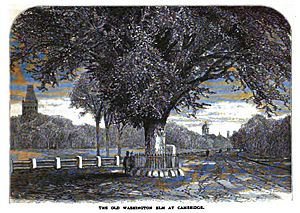Washington Elm facts for kids
The Washington Elm was a very old tree. It stood on the Cambridge Common in Cambridge, Massachusetts. This famous tree lived for about 210 years. Sadly, it died in 1923.
Contents
The Story of the Washington Elm
For many years, a popular story was told about the Washington Elm. People believed that George Washington, a very important leader, took command of the American Army right under this tree. This was said to happen on July 3, 1775.
The poet Henry Wadsworth Longfellow supposedly said these words. A made-up diary called The Diary of Dorothy Dudley was published in 1876. This book made the story even more popular. However, there are no official records that say Washington actually stood under this specific tree.
The Tree's Final Days
By 1923, the Washington Elm was very old and sick. Workers from the Cambridge parks department were carefully cutting off two of its last branches. As they cut the second branch, the entire tree fell over. It crashed onto its iron fence. It also pulled down a cable from the Boston Elevated Railway.
The fallen tree was cut into about 1,000 pieces. These pieces were sent to every state and their governments. A cross-section, which is a slice of the tree, was sent to Mount Vernon. Many pieces were given out to people. Some were mailed across the country. Even some special groups received parts of the tree.
Small root shoots from the original tree were also sent out. Many of these shoots grew into new trees. Some are still growing today. A tree in the state of Washington grew from one of these shoots. This tree was then used to create the tree seen in the picture.
The Truth About the Legend
In 1925, the story about Washington and the tree was shown to be untrue. This happened at the Cambridge Historical Society. A man named Samuel F. Batchelder shared his research. He later wrote a paper about it. He called it The Washington Elm Tradition: "Under This Tree Washington First Took Command of the American Army" Is It True?
Batchelder showed that the stories about Washington and the tree were not real. He called the whole idea a myth. However, many people still believe the old story today. Some websites still say the tree is alive. They also incorrectly state that Washington took command there.
Today, a special plaque marks where the tree once stood. You can find it on Garden Street in Cambridge. The Cambridge Historical Commission has called the tree's connection to Washington a "myth." But they also say that the image of the tree is still a symbol of patriotism in Cambridge.
Descendant Trees
Many of the 1,000 pieces and root shoots that were sent out grew into new trees. Some of these "descendant" trees are still standing today.
- Bellingham, Washington: A tree at 1621 Eldridge Ave. is believed to be a descendant of the Washington Elm. The exact story of how it got there is not fully clear.
- Loveland, Colorado: There is a Washington Elm Tree at 205 E Eisenhower Blvd. It is in the Walgreens parking lot. This tree came to Loveland in 1932. Root shoots from the original tree were sent to groups like the Daughters of the American Revolution (DAR). The tree was planted at what was then the Lincoln School. This tree is one of the few Washington Elm offshoots still growing strong.
Another DAR member, Corrine Yahn, is working to keep the tree's history alive. She teaches geology at Front Range Community College. She works with Susan Brown on something called micropropagation. This is a way to grow many new plants from very small pieces of a parent plant. For about a year, they have been using samples from the Loveland elm. They are trying to create clones of the tree.


